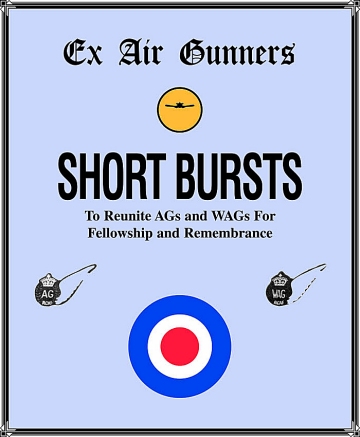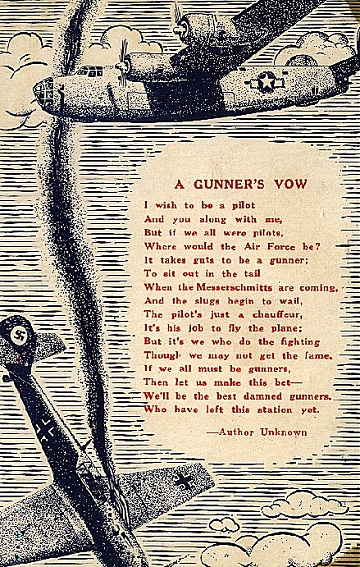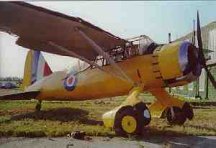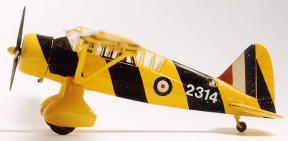
SEARCH PATTERN
Robert Farquharson was a pilot (RCAF) in the Burma Theatre and is presently writing a book about the Burma war sequentially from the beginning, but all through the eyes of Canadians who were there. Bob wants input and can be reached at:1003-55 Prince Arthur Ave., Toronto, Ont. M5R 1B3 I sent Bob a copy of the Commemorative Issue Short Bursts 1983 - 1993 and his comments are in part: ". . . it speaks of the particular pride and camaraderie that holds AG's together. I think AG's are like goalies in a hockey game - all alone at the end of the rink and, when the final shot comes, the whole win-or-lose of the game depends on them. They are a race apart." If you can help Bob, drop him a line.
Gregory Kopchuk gkopchuk@yahoo.com has developed a web site on 429 Squadronhttp://www.rcaf.com/429sqn Greg has dedicated this site, in particular, to his uncle, F/Sgt. John Kopchuk R1322169 Nav., from Melville, Sask. who was KIA 22 June 1943 while returning from Krefeld, Germany. Greg would like input from those who flew with 429 Squadron to add to his site.The crew of John Kopchuk's Wellington were:
F/Sgt EA Star (Pilot) who has no known graveMajor Kurt Holler reported downing a Wellington bomber at 0118 hrs on the 22nd of June 1943. The bodies of John Kopchuk and two others washed ashore. Major Holler was also killed at 01.41 hrs the same night.
F/Sgt J. Kopchuk (Navigator)
F/Sgt WG Parkinson (Air gunner Who has no known grave
F/Sgt JP o'Reilly (Bomb Aimer)
F/Sgt CF Orlinski (Wireless operator/Air Gunner)Bomber Command's Summary of the raid on Krefeld Germany 21/22 June 1943
705 aircraft participated - 262 Lancasters, 209 Halifaxes, 117 Sterlings, 105 Wellingtons, 12 Mosquitos. 44 aircraft were lost - 9 Lancasters, 17 Halifaxes, 9 Sterlings, 9 Wellingtons - 6.2% of the force.
The raid was carried out before the moon period was over and the heavy casualties were mostly caused by night fighters. 12 of the aircraft lost were from the Pathfinders: 35 Squadron lost 6 of its 19 Halifaxes taking part in the raid.
The raid took place in good visibility and the Pathfinders produced an almost perfect marking effort, ground markers dropped by the Oboe Mosquitos being well backed up by the Pathfinder heavies. 619 aircraft bombed these markers more than three quarters of them achieving bombing photographs within 3 miles of the center of Krefeld. 2,306 tons of bombs were dropped. A large area of fire became established and this raged, out of control, for several hours. The whole center of the city - approximately 47% of the built-up area, was burnt out. The total of 5,517 houses were destroyed, according to the Krefeld records, was the largest figure so far in the war. 1,056 people were killed and 4,550 injured. 72,000 people lost their homes; 20,000 of these were billeted upon families in the suburbs, 30,000 moved in with relatives or friends and 20,000 were evacuated to other towns.
Ron Bramley, Editor of THE TURRETIn the February Page we featured an article where Ron obtained the Air Crew Europe Medal, posthumously) for the late Roy Murfin RAAF. Well, "Bram" has donned his armor, mounted his white steed, and again sallied forth. He writes:
"..my next Crusade is for Brass Bullet Air Gunners who continued on Ops without getting their Stripes after May 1940. In fact, the person who started it off was Robert J. G. Cooper, Box 182 Barons, AB TOL OGO who you may know. He was one of those when in the ME and the OC was AVM Longmore, who said they must carry on with their ground duties when they weren't flying, but if they were shot down they would be buried as Sergeants, and that didn't happen either! Quite incredible reading. Bob Cooper, when he went to Canada and joined the RCAF he still was not promoted, and when he finished his time, he applied to joint the Canadian Air Crew Association, but was first refused because he never had a brevet! He later got in, because a friend showed Bob's Log Book to them! He hopes we will both live long enough to see it put right, and so far I have the AGA behind me, and a retired Air Commodore who knew Longmore. So wish me luck (and time). Hope to come to Canada this year (October) for the Burma Bombers Association Reunion in Comox...."
Bob Middlemass received the following via Mike Garbett, Author of Lanc.1,2,3, books:IMPROBABLE ACTION
In early 1943, the principle offensive actions which the Luftwaffe were producing against Britain were the 'hit-and-run' boys. A pair of 190's or 109's each with a pair of bombs underneath would attack anywhere along the South Cost with reasonable chance of striking a built up area.
To cope with these we had to keep up a standing patrol anywhere between The Isle of Wight and Beachy Head. Other squadrons covered other stretches of the coast. It was in pursuit of this policy that a section of two Typhoons took off from Tangmere one morning. Flying lead was Ron Fitzgibbon with Norman Preston his No.2. It could easily have been the other way around. These two had joined up together, trained together, flown together as often as they could talk the flight commander into it. Several months later they were to die within ten days of each other.
We had made habit of these sections of two taking off in tight formation. It was spectacular and did a lot of good to the moral of the ground staff. This time it was a mistake.
Just before they reached the un-stick speed, Fitz's starboard tire burst and he slewed across the runway towards Norm's take-off line. There was only one thing to do and Norm did it. He hauled back hard on the stick, managed to get off the ground and hold it up there while Fritz swept past below him. But, having done that, he paid the price of having insufficient flying speed to stay up. His aircraft cart-wheeled two or three times before ending up in a crumpled heap many yards further on. Norm was unhurt.
Fitz, meantime, was having his problems too. He was on the grass, which was quite serviceable, proceeding on a line about 30 degrees away from the runway. He was trying desperately to coax his aircraft into the air, retract the undercarriage, and come in for a belly-flop with minimal damage. But the shredded tire, dragging against the ground, resisted all attempts to accelerate. Perforce, he closed everything down and prepared for an almighty smash. It was obvious to him that he wasn't going to stop within the perimeter.
On the far side of the perimeter track was a patch of fairly rough ground - which would at least be softish. However, just slightly to the right of his path, just inside the perimeter, stood a Lancaster. It had landed badly shot up some weeks ago. The maintenance team who had been working on it had rung the Lanc. Squadron the night before to come and pick up their baby.
Fitz, who had no control of the direction he was heading, swept past the visitor on its port side and his starboard wing-tip neatly removed the Lanc's port tail unit. Meantime, the Typhoon proceeded, still at fairly high speed, under the big fella's port wing. Which was far enough off the ground for it to go through. Not the prop thought, it was still rotating, though slowly. And it was, of course, going forward at the same time. It therefore, during its under-wing passage cut a quadrant shaped hole in the Lanc wing, starting just forward of the trailing edge and ending just aft of the edge. In the process, it severed the main spar.
Fitz carried on into the rough ground, bumped his way through it, though it at least helped to decelerate him. He finally came to rest in the corner of a blister hangar which contained a Spitfire. It had, but a few seconds previous, contained the ground crew who'd been working on the Spit. They made a hurried exit when they saw Fitz approaching.
One of the ground crew had, on arrival at work, propped his bike against the corner of the hangar where Fitz ended up. That bicycle was yet another casualty. Also the hangar itself, not having been designed to withstand charging Typhoons. After all, it was only a blister hangar, so it promptly collapsed over both aircraft and Fitz. Doing both aircraft considerable damage, but doing Fitz no damage at all.
So, in about 45 seconds of improbable action, the total score was:- Two Typhoons, one Lancaster, one Spitfire, one Blister hangar, and one bicycle.
"S" Squadron - Halifax 1V's at Marston Moor, Yorkshire. Never heard of them? Read on....
THE TOP SECRET TRUTH OF THE HALIFAX 1V BOMBER
Based upon the writing and memoirs of Mr. Harry Thomas Esq. (RAF Retd.)
~ Edited by Chief Technician David Curry RAF ~During October 1995, I researched the loss of a 102 Squadron Halifax 111 heavy bomber, based at Pocklington. My investigations revealed that the particular aircraft and its crew were shot down by flax while attacking Koblenz, the seven man crew were lost. While obtaining information from the Public Archives Office relating to this bomber, I came across a previous top secret classified document detailing the formation of a specialist and highly unusual Halifax bomber squadron in Yorkshire. The document revealed that from mid 1943 a special high altitude day bomber force of 20 Halifax 1V's were operating from Marston Moor airfield. The unit was not assigned a squadron number, but was merely identifies as S (Special) Squadron, and was administratively controlled by 4 Group HQ of RAF Bomber Command. The document said that the Halifax 1V had been designed to fly at high speed, extreme altitudes, and was fitted with very special engines. Similarly, they contained the latest in blind bombing aids, namely H2X, and were fitted with the high altitude tachometer bombsight.
Upon checking I found that the only entry I could find describing the Halifax 1V was, and I quote, "Halifax 1V - Experimental aircraft built for the purpose of testing new engine mountings". This seemed rather odd as I had read archives saying that they were conducting operations to Germany from 1943 to the end of the war. I next approached the Air Research Branch in London and gained access to previously classified government papers relating to a meeting, held in 1942, of a committee
set up to discuss the design of a new type of bomber. Shortly afterwards I was introduced, through the 4566 Sqn. association, to a Mr. Harry Thomas, who, as a young man, had served with 466 Sqn., 35 Sqn., and then S Sqdn. The story he told me regarding the introduction to service of the Halifax 1V must surely be one of the strangest to be uncovered from World War Two.Prior to joining the RAF in 1940, Harry Thomas was a trainee Fireman/Stoker working on the foot plate of the LNER. At the outbreak of the war he joined up hoping to become a pilot, but after selection ended up as a flight engineer destined for Bomber Command. After completion of his training in Canada, Harry Thomas commenced his flying career on Hampdens and then on Wellington bombers. His Squadron then re-equipped with the new four-engined "heavy" Halifax 1, and the entire Squadron underwent HCU (heavy conversion unit). He did not realize at the time but his pre-war and wartime training would introduce him to one of the best kept secrets of the war. The advent of the four-engined heavy bombers meant that more and more 100 octane fuel was needed, and this while our convoys were still suffering terrible losses carrying fuel from the USA. Invetiably, something had to give. Just as petroleum and oil would prove to be the Achilles heel of Germany towards the end of the war, it was also causing concern within Bomber Command.. A solution was sought at the highest level of government and many scientist and learned bodies were approached. Eventually, a Junior Minister of Fuel and Production, named Stephenson, suggested we utilize our most abundnt fuel supply, namely, coal. The Germans were producing thousands of tons of aviation spirit every month from coal, but it ws a very inefficient method and only viable because of the vast European stocks on hand. Unfortunately, the German fuel was low octane, and while the enemy's engines were designed to run on low grade petrol, our engines were not and would suffer irrepairable damage. Similarly, the conversion of so many of our refineries to the method would cause too much disruption to our already hard pressed fuel output.
Experts from the Air Ministry and Industry joined forces and came up with the surprising solution by re-designing the already proven and tested Sentinal Super-heated steam engine. After much experimenting it was found that two Sentinal engines could, via the use of drive shafts and adapted gear boxes drive four propellers. One engine would be located within the inner ort and starboard nacelle of the heavy bomber and, drive shafts running through the central wing spar, would drive the two outer gear boxes and propellers. The vertical boiler driving the two engines was located behind the main spar inside the fuselage and, although heavy, was surprisingly compact and able to be fed coal from the top by a single stoker. The water required to produce the steam could be stored in the redundant petrol tanks to the capacity of 2000 gallons, and coal could be positioned within the fuselage and wing roots. A novel feature of the aircraft was that pipes of super heated steam were routed through the leading wing edges to prevent icing. The auxiliary equipment, turrets, bomb doors, undercarriage, etc. all previously powered by hydraulics, would now operate under steam pressure. Electrical circuits were fed from a generator located along side the port engine. While the Avro Lancaster was ultimately to become the most famous of the heavies, the Halifax was by far the stronger aeroplane and more flexible. It became the obvious test bed for the hybrid bomber. So was born the Halifax 1V with its revolutionary engines, strengthened fuselage, and increased wing span to assist in its high altitude role. Initially only two Halifax 1V's were built to specification but, after testing, the Air Ministry realized they had a heavy bomber capable of hitting German targets almost with impunity. The climb rate was relatively slow due to the weight, but it could cruise comfortably at 40,000 feet and had an absolute ceiling of 42,000 feet, loaded. Its speed was even more remarkable at 450 mph cruising and just over 500 mph flat out. 20 aircraft were ordered from Handley Page. Recruitment/training of crews began by late 1942. Flight Engineer Sgt. Thomas was posted to Marston Moor airfield, near York in November 1942. The Engineering Officer, Sqn. Ldr. "Steamer" Gargill, welcomed Harry and others to Marston Moor and briefed them on their new and highly secret
aircraft. It proved to be an eye-opener as the Haliflax1V looked so normal, except it had "large wings, the inboard engine nacelles were bigger than the outboard ones, there appeared to be only two exhaust ports, and in place of the upper turret, there was a small circular funnel. As the Flight Engineer/Stoker, Harry was now issued a new brevet inscribed "FES".Flying training began almost at once in order to familiarize the crews with their new aircraft. For most, the conversion to the Halifax 1V was straight forward and not that difficult; however, they all marveled at the aircraft's performance when carrying its 8000 lbs. bomb load. The crews were taught to replenish water stocks by flying through clouds where, with their steam cooling radiators fully open, thus killing two birds with one stone so to say, the radiator, acting as a condenser, with the cold thick cloud taking the heat out of the steam and the cloud then turning into distilled water, they could top up their tanks.
The only draw back of the aircraft was that it left a vapor trail at all altitudes and was clearly visible to all. For training sorties they burned normal coal which left a dark smoke trail, but for operations they loaded up with 5 tons of smoke-less coal which was produced from the nearby Coalite works at Wetherby. Fully loaded, the Halifax 1V had endurance, at cruising speed/altitude, of almost 6 hours. This was more than enough to attack the most distant German targets.(to be continued)
When the Ex-Air Gunner's web page is updated April 1, 2001, we will inform our readers of the many occasions S Sqn. Carried out raids into western Europe. Imagine, cruising at 40,000 feet wearing shorts and shirt sleeves! Stay tuned.
RODGER HOLTON rholton@cgocable.netRodger has his late father's WW11 memorabilia and he is looking for a collector who might be interested. Rodger advises that his Dad obtained his AG Brevet June 1940, Observer Radio July 1941, Navigator Radio Nov. 1942. He joined 141 Sqn. August 1940 and went on to fly with 89 Sqn., 1943, then 176 Sqn. And finished operations on 552 Sqn.
The items consist of:
1. Two log books starting in European theatre and also coveringRodger will be making a donation to the CATP Museum in Brandon Man.
2. ...operations in India and the far Eastern theatre.
3. Pictures from a scrap book of other aircrew and photos of aircraft taken on the ground and from the air. One picture signed by Jock Laurence DFM who was KIA in North Africa 1942. Jock was Rodgers father's pilot.
4. Menu, Sgt's Mess 176 Sqn. Christmas 1943, India, with 16 signatures on it.
5. Navigator's "Douglas" combined protractor & Parallel Rule - Stores Ref No. 6/B47.
NEW MEMBER Sid is very active with 150 RCAF (North Atlantic) Wing having been Past President, Sec. Treas., and is now on Planning and Policy Committee. Sid is the first new member recruited through the web.Sidney Butler - 53 Poplar Ave., St. John's NF. A1B 1C7 - Ph. (709)726-8569
To make this Web Page a success we need material from Members so the Page can be up-dated each month. Lets give the chaps something to look forward to. Send pictures and copy to John Moyles - address and Email is on this page. From Your Editor
Member Ray Stoy from Florida is sending some photos of his WW11 a/c paintings. It is hoped that we can get more pictures on the Page as we become expert in this new medium.
Until April, keep well. Cheers, John Moyles
OBITUARIES: March 2001
|
From his son, John T. Owens: My Dad passed away Dec. 4, 2000 of a massive heart attack at the age of 76. He was a proud member of the RAF Coastal Command during 1944-45. He flew in the Liberator occupying the various gun positions as was needed during missions. He is missed dearly and just typing this is difficult. He attended the Reunion in Edmonton in September 2000 which was certainly a great highlight for him. Thanks to all for making in a memorable event for him!! Also 'Thanks' to John Moyles for "Short Bursts", Dad constantly watched the mailbox with anticipation for every issue. Ted's Service Number was R295250 and took his B&G Training at #10 Mount Pleasant, PEI |
|
Passed away in January, 2001. Took his Gunnery Course at Fingal and Stormy Downs, Wales. Served as a Flying Officer J96511 with 419 Squadron in 6 Group. Crew shot down July 11, 1943 and remained POW at Stalag Luft 6 in East Prussia until May 8th, 1945. |
 |
I wish to be a pilot
~Author Unknown~ |
|
Winnipeg
Northern Saskatchewan
Northern Alberta Branch
Southern Alberta
send current information regarding regular meeting places, dates, and Contact Members, to John Moyles Box 6 Kenosee Lake SK S0C 2S0 E-mail: tweedhouse@sk.sympatico.ca Members are requested to send their experiences, articles, anecdotes, pictures, etc., to John Moyles and I will forward them to our Web Master in Brandon. Articles and Last Post items will be deleted from the page each month after the designated Member in each region has had an opportunity to copy the material for their Members. Notices of deceased Members are to be sent to Charlie Yule who is still our 'Keeper of the Rolls'. This is your SHORT BURSTS with no printing or mailing costs, and no deadlines! The Brandon Commonwealth Air Training Plan Museum has agreed to host our AG page. However, as it costs the Museum $35.00 per month to maintain the Web Page, it is suggested that each Ex-AG group contribute periodic donations to the Museum to help off-set this expense, and to enhance the work they are doing. We thank our Web Master, Bill Hillman, for his volunteer time and expertise. Donations can be made directly to: CATP Museum Inc.
|


|
|

BACK TO THE CATP MUSEUM CONTENTS PAGE
Visit Our Current Monthly Online e-Zine
and Past Issues Archive at:
As You Were: ContentsWebmaster: William G. Hillman
BILL & SUE-ON HILLMAN ECLECTIC STUDIO
© 2001 Bill Hillman